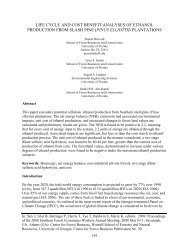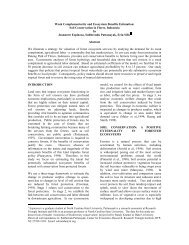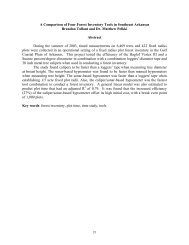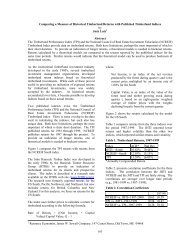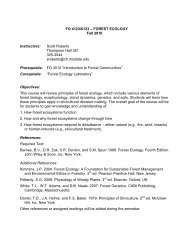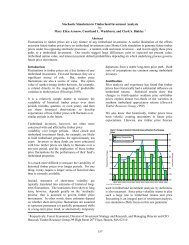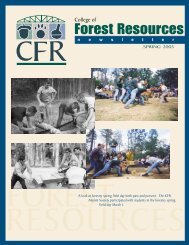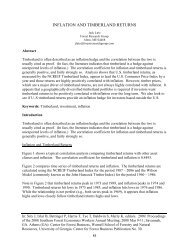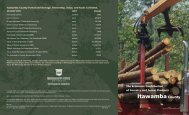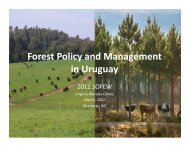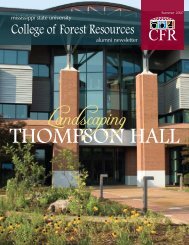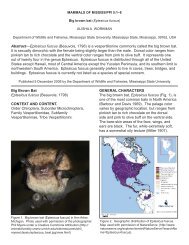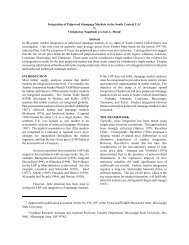A Long-Term Analysis of Hardwood Lumber Prices by ... - sofew
A Long-Term Analysis of Hardwood Lumber Prices by ... - sofew
A Long-Term Analysis of Hardwood Lumber Prices by ... - sofew
You also want an ePaper? Increase the reach of your titles
YUMPU automatically turns print PDFs into web optimized ePapers that Google loves.
A <strong>Long</strong>-<strong>Term</strong> <strong>Analysis</strong> <strong>of</strong> <strong>Hardwood</strong> <strong>Lumber</strong> <strong>Prices</strong><br />
<strong>by</strong><br />
William G. Luppold<br />
Jeffrey P. Prestemon<br />
and<br />
John E. Baumgras 1<br />
ABSTRACT<br />
This study examined the interrelationship in prices <strong>of</strong> eight hardwood species using descriptive analysis and the<br />
Johansen method for testing cointegration. The descriptive analysis found that the lumber prices <strong>of</strong> the various<br />
hardwood species seem to follow independent trends largely due to changing domestic and international markets.<br />
Still, there might be a substitution mechanism that keeps prices <strong>of</strong> various species close to one another over the long<br />
run which may be revealed using cointegration. The cointegration analysis revealed that prices for various species<br />
<strong>of</strong> hardwood lumber are not cointegrated. However, there were several situations in which cointegration was<br />
found. <strong>Prices</strong> <strong>of</strong> high-grade lumber <strong>of</strong> all eight species examined were cointegrated with the price <strong>of</strong> black walnut.<br />
<strong>Prices</strong> <strong>of</strong> open-grained species were found to be cointegrated with one another. The price <strong>of</strong> yellow-poplar prices<br />
also were found to be cointegrated with several open- and closed-grained species.<br />
INTRODUCTION<br />
<strong>Hardwood</strong> lumber and timber has traditionally been<br />
treated as a commodity without respect to species<br />
(Haynes 1990). Although this assumption may be<br />
useful for policy analysis, it may be less relevant for<br />
forest management decisions. <strong>Hardwood</strong>s are a<br />
broad collection <strong>of</strong> species with variations in color,<br />
density, and other physical properties. Because<br />
hardwood lumber demand is influenced <strong>by</strong> style,<br />
different species are dominant at different times<br />
(Frye 1996). As a result the relative price <strong>of</strong><br />
different hardwood species has varied over time<br />
(Table 1).<br />
The variation in hardwood lumber and subsequent<br />
timber prices makes timber management difficult. It<br />
takes 60 to 80 years for hardwood stands to achieve<br />
the minimal diameter and quality attributes desired<br />
<strong>by</strong> sawmills. This lengthy production cycle makes it<br />
difficult for forest planners to decide on what species<br />
to favor during the regeneration period following a<br />
partial cut or clearcut. If we can determine that<br />
hardwood lumber prices are independent or<br />
interrelated, this information may be useful to forest<br />
managers when projecting future market conditions.<br />
In this paper we examine if hardwood prices move<br />
independently <strong>of</strong> one another or are interrelated.<br />
<strong>Prices</strong> <strong>of</strong> hardwood lumber will first be examined<br />
using a descriptive approach that integrates changes<br />
in lumber prices with changes in fashion and<br />
international demand. This analysis is followed <strong>by</strong> a<br />
cointegration analysis <strong>of</strong> hardwood lumber prices.<br />
The concluding section <strong>of</strong> the paper will summarize<br />
important findings.<br />
HISTORIC ANALYSIS OF HARDWOOD<br />
MARKETS AND PRICES<br />
In the 1950’s and 1960’s walnut was the most<br />
valuable species and other closed-grained species<br />
(cherry, hard maple, and s<strong>of</strong>t maple) were priced<br />
higher than open-grained species (oak and ash).<br />
During this period, walnut was the most commonly<br />
shown wood at the furniture markets followed <strong>by</strong><br />
maple (hard and s<strong>of</strong>t) and black cherry (Table 2).<br />
Yellow-poplar was valued more than the oaks (red<br />
and white) and maple because this species was used<br />
in combination with walnut, cherry, and mahogany<br />
veneers. Although furniture made from white oak<br />
was exhibited at furniture markets in the late 1940’s<br />
and early 1950’s (Table 2), oak furniture did not sell<br />
well.<br />
In 1973, walnut was still the most expensive<br />
hardwood species while the oaks, the maples (hard<br />
and s<strong>of</strong>t), and yellow-poplar traded at similar prices.<br />
The high price <strong>of</strong> walnut may have resulted from a<br />
low supply caused <strong>by</strong> previous over cutting rather<br />
than from strong demand because it was being used<br />
less <strong>by</strong> furniture manufacturers. The early 1970’s<br />
also was a period <strong>of</strong> turmoil for both the general<br />
1 The authors are, respectively, Project Leader, USDA Forest Service, Northeastern Research Station, 241 Mercer<br />
Springs Road, Princeton, WV 24740; Research Forester, USDA Forest Service, Southern Research Station, P.O.<br />
Box 12254, Research Triangle Park, NC 27709; and Project Leader, USDA Forest Service, Northeastern Research<br />
Station, 241 Mercer Springs Road, Princeton, WV 24740
economy and the hardwood lumber market. Wage<br />
and price controls imposed <strong>by</strong> the Nixon<br />
Administration caused shortages <strong>of</strong> nearly every<br />
species, resulting in sharp increases in prices after the<br />
controls were lifted. In addition the adoption <strong>of</strong><br />
floating exchange rates during this time caused an<br />
increase in exports <strong>of</strong> oak and other species. The<br />
most significant change during this period was the<br />
increase in red oak furniture showings.<br />
____________________________________________________________________________________________<br />
_<br />
Table 1. - Nominal prices for Number 1 Common hardwood lumber for select hardwood species 1953 - 1999<br />
____________________________________________________________________________________________<br />
_<br />
Year Ash Beech Birch Black Hard S<strong>of</strong>t Red White Yellow- Black<br />
cherry maple maple oak oak poplar walnut<br />
____________________________________________________________________________________________<br />
_<br />
1953 115 130 150 150 135 115 120 125 138 180<br />
1959 140 115 155 180 160 143 115 115 130 220<br />
1963 117 120 163 180 157 160 105 110 135 240<br />
1969 219 142 180 205 172 195 170 163 167 330<br />
1973 251 190 200 260 245 235 250 245 250 450<br />
1979 504 245 290 600 350 335 410 410 275 835<br />
1986 445 235 235 570 342 320 510 405 260 865<br />
1989 700 255 300 770 385 350 535 445 285 855<br />
1993 528 335 385 1040 760 600 800 540 430 855<br />
1999 560 415 535 1135 845 580 775 530 380 775<br />
____________________________________________________________________________________________<br />
_<br />
Source: Data base maintained at the Northeastern Research Station’s Forestry Sciences Laboratory at Princeton,<br />
WV, under the agreement with the <strong>Hardwood</strong> Market Report, Memphis, TN.<br />
____________________________________________________________________________________________<br />
_<br />
Table 2. - Percentage <strong>of</strong> predominant species on exposed surfaces in bedroom and dinning room furniture show at<br />
major US furniture shows, 1946 to 1999 (Source: Frye 1996, 1999).<br />
____________________________________________________________________________________________<br />
_<br />
Year Walnut Mahogany Maple Cherry Oak Other<br />
____________________________________________________________________________________________<br />
_<br />
1946 22 34 9 1 9 25<br />
1952 15 28 13 11 12 21<br />
1958 27 21 13 19 4 16<br />
1964 28 5 17 29 3 18<br />
1970 16 3 12 10 14 45<br />
1976 8 3 7 6 18 58<br />
1982 3 5 6 11 26 49<br />
1988 2 8 4 12 24 50<br />
1994 1 7 7 17 28 40<br />
1999 1 6 9 18 19 47<br />
____________________________________________________________________________________________<br />
_<br />
a/ Shown at Grand Rapids, Michigan<br />
b/ Shown at Chicago, Illinois 1948 to 1959<br />
c/ Shown at High Point, North Carolina 1960 to present
As the 1970’s progressed, red oak became a major<br />
species used in domestic markets while white oak<br />
was being exported to Europe in increasing amounts.<br />
The maples became less important as furniture<br />
species while cherry maintained a continual presence<br />
at the furniture market (Table 2). In the 1980’s,<br />
demand for oak continued to increase while<br />
showings <strong>of</strong> maple and walnut furniture continued to<br />
drop.<br />
In the 1980’s, prices <strong>of</strong> red and white oak continued<br />
to increase in value while the maples sold at<br />
relatively low prices. Red oak continued to be used<br />
<strong>by</strong> domestic manufacturers while white oak was<br />
exported. The export <strong>of</strong> white oak caused the price<br />
<strong>of</strong> high-quality white oak to increase but the price <strong>of</strong><br />
The ebb and flow <strong>of</strong> lumber prices for individual<br />
hardwood species over the last 50 years can be<br />
attributed to style. But what if style is partially<br />
dependent on price resulting in a long-term species<br />
substitution mechanism that eventually bring together<br />
the prices <strong>of</strong> different hardwood lumber species? Or,<br />
do hardwood lumber prices truly move<br />
independently? Given these questions, how do we<br />
test if hardwood lumber prices are interrelated or<br />
independent?<br />
Another way to examine the strength <strong>of</strong> the<br />
relationship between two wood products is to test<br />
whether their prices, expressed in linear combination,<br />
form a stable statistical relationship in the long run,<br />
that is, whether they are cointegrated. Consider the<br />
following expression <strong>of</strong> the linear combination <strong>of</strong><br />
two time series <strong>of</strong> product prices, {p 1t } and {p 2t },<br />
that are both nonstationary, integrated <strong>of</strong> order 1:<br />
[1] p 1,t = a + Bp 2,t + e t<br />
If there exists a linear combination <strong>of</strong> p 1 and p 2 , a<br />
unique pair <strong>of</strong> values for a and B such that the<br />
resulting residual series, {e t }, is I(0) (i.e., it is<br />
stationary), the two I(1) prices can be considered<br />
cointegrated with parameters a and B. This means<br />
that the price pair has a stable, long-term relationship<br />
that endures even following substantial changes in<br />
levels <strong>of</strong> the series.<br />
Equation [1] introduces a concept attributed to Engle<br />
and Granger (1987) that should allow tests <strong>of</strong> long<br />
run relationships between two nonstationary series<br />
posited to possess a common trend. Although, there<br />
has been little analysis <strong>of</strong> the interrelationship <strong>of</strong><br />
hardwood lumber prices in this manner or in others,<br />
there has been numerous studies <strong>of</strong> regional<br />
mid-quality white oak did not increase as fast as that<br />
<strong>of</strong> red oak (Table 1). Yellow-poplar prices remained<br />
low during this period due to relatively low demand<br />
and increasing sawtimber inventories.<br />
In the early 1990’s, showings <strong>of</strong> maple and cherry at<br />
the High Point, North Carolina furniture market<br />
began to increase. In addition, white hard maple<br />
was being used with cherry veneer. Oak showings<br />
hit nearly 30 percent in the early 1990’s resulting in a<br />
noticeable spike in the price <strong>of</strong> red oak lumber. By<br />
the end <strong>of</strong> the decade, black cherry was the highest<br />
value species followed <strong>by</strong> hard maple, mid-grade<br />
walnut traded at the same price as red oak while<br />
white oak traded at price levels comparable to those<br />
<strong>of</strong> s<strong>of</strong>t maple.<br />
s<strong>of</strong>twood lumber prices and price relationships <strong>of</strong><br />
s<strong>of</strong>twood lumber imports. These studies can provide<br />
insight on the current analysis since s<strong>of</strong>twood species<br />
also differ in physical attributes.<br />
COINTEGRATION ANALYSIS OF SOFTWOOD<br />
MARKETS<br />
Uri and Boyd (1990) surmised that the market for<br />
s<strong>of</strong>twood lumber is national and that price<br />
movements in one region matched price movements<br />
in other regions. Using multivariate cointegration<br />
tests to examine regional s<strong>of</strong>twood lumber price,<br />
Jung and Doroodian (1994) concluded that the law <strong>of</strong><br />
one price 2 held in the U.S. s<strong>of</strong>twood lumber market.<br />
Hseu and Buongiorno (1992) examined the<br />
interrelationships between different species <strong>of</strong><br />
s<strong>of</strong>twood lumber <strong>by</strong> studying elasticities <strong>of</strong> demand<br />
<strong>of</strong> imports from Canada. They concluded that each<br />
<strong>of</strong> the six species studied (one <strong>of</strong> which was an<br />
aggregate) behaved like a distinct economic good. In<br />
general, price elasticity <strong>of</strong> substitution between<br />
species was statistically significant though small in<br />
magnitude. Hänninen (1998) examined whether the<br />
law <strong>of</strong> one price behavior could be isolated in s<strong>of</strong>t<br />
sawnwood (s<strong>of</strong>twood lumber) imports into the<br />
United Kingdom. Hänninen’s cointegration analysis<br />
using the Johansen (1991) method did not support the<br />
law but revealed differences over the long run<br />
between the s<strong>of</strong>twood lumber supplied <strong>by</strong> different<br />
countries.<br />
2 The law <strong>of</strong> one price states that prices <strong>of</strong><br />
homogenous commodities are equal throughout the<br />
world (or the United States in the case <strong>of</strong> Jung and<br />
Doroodian 1994) when adjusted for exchange rates<br />
and transportation costs.
The literature suggests that aggregate regional prices<br />
may be interrelated but prices <strong>of</strong> specific species may<br />
not. The literature also suggests that cointegration<br />
analysis may be a useful method to test the<br />
interrelationship between the hardwood lumber<br />
prices. Cointegration is especially relevant because<br />
there are no reliable estimates <strong>of</strong> hardwood lumber<br />
production and demand <strong>by</strong> species. Our approach is<br />
to test this cointegration conjecture across many<br />
species grades for higher quality hardwood lumber<br />
(grade First and Seconds or FAS and grade Number<br />
1 Common or 1C) based on the relationships<br />
described in equation [1]. <strong>Prices</strong> <strong>of</strong> grades FAS and<br />
1C were selected for this analysis because they seem<br />
to be more indicative <strong>of</strong> the value <strong>of</strong> timber than<br />
prices <strong>of</strong> lower quality lumber.<br />
DATA<br />
The price series used in this analysis are Appalachian<br />
lumber prices from 1953 to 1998 as reported <strong>by</strong> the<br />
<strong>Hardwood</strong> Market Report 3 for ash, black cherry, hard<br />
maple, s<strong>of</strong>t maple, red oak, white oak, yellow-poplar,<br />
and black walnut. For cointegration testing, nominal<br />
prices are transformed <strong>by</strong> natural logarithm.<br />
Nominal, rather than deflated (“real”) prices were<br />
used because a deflation can impose a filtering<br />
process that can result in spurious patterns and<br />
spuriously significant relationships among variables<br />
(Schnute 1987).<br />
The logarithmic transformation is justified such that<br />
if prices <strong>of</strong> two products are initially very different<br />
but are equally affected <strong>by</strong> inflation, then they have a<br />
constant ratio over time but not a constant difference.<br />
This transformation also is appropriate for economic<br />
time series that are assumed to be logarithmically<br />
normally distributed (e.g., Engle and Granger 1987).<br />
ARE HARDWOOD LUMBER PRICES<br />
COINTEGRATED?<br />
Equation [1] was estimated using maximum<br />
likelihood techniques outlined <strong>by</strong> Johansen (1991).<br />
Results <strong>of</strong> the between-species tests <strong>of</strong> cointegration<br />
for grade FAS and 1C are shown in Tables 3 and 4,<br />
respectively. While most combinations <strong>of</strong> species<br />
were found not to be cointegrated, there were<br />
exceptions that could be explained. Red oak was<br />
found to be cointegrated with white oak and hard<br />
3 A historic series <strong>of</strong> hardwood lumber prices (1953<br />
to present) are maintained at the Northeastern<br />
Research Station’s Forestry Sciences Laboratory at<br />
Princeton WV, under an agreement with the<br />
<strong>Hardwood</strong> Market Report, Memphis, TN.<br />
maple and s<strong>of</strong>t maple were found to be cointegrated.<br />
These results were expected because red and white<br />
oak are similar in appearance as are hard and s<strong>of</strong>t<br />
maple. Yellow-poplar was found to be cointegrated<br />
with ash, black cherry, red oak, white oak, and black<br />
walnut, supporting the notion that yellow-poplar is<br />
used with other species. Black walnut was found to<br />
be cointegrated with all species examined. This<br />
species historically has been the premier hardwood,<br />
particularly in high-end applications. These results<br />
suggest that the FAS prices <strong>of</strong> all other hardwood<br />
lumber might have somehow been set as a function<br />
<strong>of</strong> the price <strong>of</strong> black walnut.<br />
Many <strong>of</strong> the significant between-species<br />
cointegration statistics <strong>of</strong> 1C in Table 4 also can be<br />
explained. Red and white oaks were found to be<br />
cointegrated but hard and s<strong>of</strong>t maple were not.<br />
Yellow-poplar was found to be cointegrated with five<br />
species and had a high log ratio statistic (but more<br />
than 1 cointegration equation) with s<strong>of</strong>t maple. Black<br />
walnut was found to be cointegrated with all the<br />
open-grained species and yellow-poplar. Ash was<br />
found to be cointegrated with red oak, white oak,<br />
walnut, and yellow-poplar.<br />
IMPLICATIONS AND CONCLUSIONS<br />
The analysis <strong>of</strong> lumber prices for various grades <strong>of</strong><br />
eight Appalachian hardwood species found that the<br />
many species were not cointegrated with one another<br />
and that independent markets exist for these species.<br />
However, there were some notable exceptions.<br />
Grade FAS black walnut was found to be<br />
cointegrated with FAS lumber <strong>of</strong> most other species.<br />
Mid-grade walnut was found to be cointegrated with<br />
the oaks, ash, and yellow-poplar.<br />
After black walnut, yellow-poplar had the greatest<br />
number <strong>of</strong> cointegrated relationships between<br />
species. This finding weakly supports a previous<br />
finding <strong>by</strong> Luppold (1983) that yellow-poplar is a<br />
complementary species in the production <strong>of</strong> furniture.<br />
Grade FAS yellow-poplar was cointegrated with<br />
black walnut, black cherry, and open-grained species.<br />
Grade 1C yellow-poplar was cointegrated with all<br />
species except black cherry and s<strong>of</strong>t maple.<br />
In general, the oaks and other open-grained species<br />
tended to be cointegrated with one another, while<br />
closed-grained species tended to be cointegrated with<br />
little other than FAS walnut and, in several cases,<br />
yellow-poplar. The lone exception was that FAS<br />
hard and s<strong>of</strong>t maples were found to be statistically<br />
related.
Only half <strong>of</strong> the relationships examined showed no<br />
interrelationships between species. What this means<br />
in terms <strong>of</strong> forest management is ambiguous.<br />
However, if relative hardwood lumber prices are<br />
erratic over the next 50 years, as they were over the<br />
past 50 years, then the selection <strong>of</strong> the best species<br />
for regeneration appears to be more <strong>of</strong> an act <strong>of</strong> faith<br />
than a predictable outcome. Still, the initial<br />
management premise we attempted to establish -- that<br />
forest managers should not concentrate on<br />
regenerating and managing for specific species but<br />
expend resources on maintaining stand quality for<br />
species most suited for a specific site -- might be<br />
valid. First, prices <strong>of</strong> FAS lumber are cointegrated<br />
with the species that historically has been the most<br />
valuable (black walnut). Second, previous research<br />
has shown that high-quality timber has increased in<br />
value faster than timber prices in general (Luppold<br />
and Baumgras 1995).<br />
Literature Cited<br />
Engle, R. F., and C. W. J. Granger. 1987. Cointegration<br />
and error correction: representation,<br />
estimation, and testing. Econometrica 55(2):251-<br />
276.<br />
Frye, L. 1996. The most popular furniture woods:<br />
the historic perspective. Wood and Wood Prod.<br />
100(14):304-307<br />
Frye, L. ed. 1999. Wood unlimited news. April.<br />
Haynes, R. 1990. An analysis <strong>of</strong> the timber situation<br />
in the United States: 1989-2040. USDA For. Serv.<br />
Gen. Tech. Rep. RM-199.<br />
Hseu, S., and J. Buongiorno. 1992. Price elasticities<br />
<strong>of</strong> substitution between species in the demand <strong>of</strong> U.S.<br />
s<strong>of</strong>twood lumber imports from Canada. Can J. For.<br />
Res. 23:591-597<br />
Johansen, S. 1991. Estimation and hypothesis testing<br />
<strong>of</strong> cointegration vectors in Gaussian vector<br />
autoregressive models. Econometrica 59(6):1551-<br />
1580.<br />
Jung, C., and K. Doroodian 1994. The law <strong>of</strong> one<br />
price for U.S. s<strong>of</strong>twood lumber: a multivariate<br />
cointegration test. For. Sci. 40(4):595-599.<br />
Luppold, W. G. 1983. The effect <strong>of</strong> changes in<br />
lumber and furniture prices on wood furniture<br />
manufacturers’ lumber use. USDA For. Serv. Res.<br />
Pap. NE-514.<br />
Luppold, W.G., and J.E. Baumgras. 1995. Price<br />
trends and relationships for red oak and yellowpoplar<br />
stumpage, sawlogs, and lumber in Ohio:<br />
1975-1993. Nort. J. Appl. For.P 12(4):168-173.<br />
Schnute, J. 1987. Data uncertainty, model<br />
ambiguity, and model identification. Nat. Res. Mod.<br />
2(2):159-212.<br />
Hänninen, R. A. 1998. The law <strong>of</strong> one price in<br />
United Kingdom s<strong>of</strong>t sawnwood imports-- a<br />
cointegration approach. For. Sci. 44(1):17-23<br />
Uri, N. D., and R. Boyd. 1990. Considerations on<br />
modeling the market for s<strong>of</strong>twood lumber in the<br />
United States. For. Sci. 36(3):680-692.<br />
____________________________________________________________________________________________<br />
Table 3 - Results <strong>of</strong> cointegration analysis for grade First and Seconds Appalachian hardwood lumber<br />
____________________________________________________________________________________________<br />
Specie Black Yellow- White Red S<strong>of</strong>t Hard Black<br />
walnut poplar oak oak maple maple cherry<br />
____________________________________________________________________________________________<br />
----------------------------------------Log ratio rank--------------------------------------------<br />
Ash 35.61 c/ 20.63 b/ 14.24 16.10 12.64 10.42 15.02<br />
Black cherry 22.39 b/ 20.20 b/ 11.53 11.10 14.57 8.87<br />
Hard maple 19.70 a/ 13.50 9.62 11.20 23.56 b/<br />
S<strong>of</strong>t maple 19.58 a/ 16.12 12.74 12.24<br />
Red oak 24.96 c/ 21.76 b/ 23.70 b/<br />
White oak 21.95 b/ 20.66 b/<br />
Yellow-poplar 23.43 b/<br />
____________________________________________________________________________________________<br />
_<br />
a/ Significant at the 10-percent level<br />
b/ Significant at the 5-percent level<br />
c/ Significant at the 1-percent level
____________________________________________________________________________________________<br />
Table 4 - Results <strong>of</strong> cointegration analysis for grade Number 1 Common Appalachian hardwood lumber<br />
____________________________________________________________________________________________<br />
Species Black Yellow- White Red S<strong>of</strong>t Hard Black<br />
walnut poplar oak oak maple maple cherry<br />
__________________________________________________________________________________________<br />
----------------------------------------Log ratio rank--------------------------------------------<br />
Ash 22.89 b/ 28.19 c/ 20.07 b/ 21.83 b/ 17.11 12.05 14.45<br />
Black cherry 14.11 13.23 22.29 b/ 17.29 12.07 8.51<br />
Hard maple 10.52 13.91 9.57 7.60 16.21<br />
S<strong>of</strong>t maple 12.57 24.56 c/ 18.33 a/ 16.21<br />
Red oak 23.54 b/ 25.90 c/ 22.90 b/<br />
White oak 22.63 b/ 29.94 c/<br />
Yellow-poplar 29.94 c/<br />
____________________________________________________________________________________________<br />
_____<br />
a/ Significant at the 10-percent level<br />
b/ Significant at the 5-percent level<br />
c/ Significant at the 1-percent level



